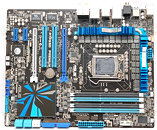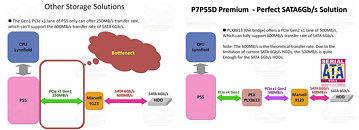Wednesday, August 19th 2009

ASUS Prepares P7P55D Premium, Equips SATA III
Here's our ASUS P55 motherboard of the day: the P7P55D Premium. Positioned in the high-end segment of socket LGA-1156 motherboards, this board boasts of support for SATA III 6 Gbps. Associated with the SATA III controller, is also an interesting feature. To begin with, the CPU is powered by a digital PWM circuit with "32+3" phases. Sure there are that many chokes, but we do suspect choke redundancy here. The CPU is wired to four DDR3 DIMM slots to support dual-channel memory.
Unlike the P7P55D Deluxe, this board makes do with two PCI-E 2.0 x16 slots, each of which arrange to 8-lanes PCI-E when both are populated. Other expansion slots include two PCI-E x1 and two PCI. Connectivity options include two gigabit Ethernet controllers, 8 channel audio, and a number of USB and Firewire ports. From the looks of it, there's also a place-holder for the NEC µPD720200 USB 3.0 controller, and its marked blue-coloured USB ports, though it's MIA.The P55 PCH provides six SATA II ports, and an additional Marvell 88SE9123 controller gives out two next-generation SATA III ports. ASUS used an interesting (and expensive) method of making sure the controller works to its full potential. A PCI-Express 2.0 switch was added to the board, that connects to all the four PCI-E 1.1 lanes the P55 PCH provides, and gives out 12 PCI-E 2.0 lanes, with support for three ports in all. One of these ports, configured as PCI-E 2.0 x1, connects to the Marvell 88SE9123 (which is a PCI-E 2.0 x1 device) to make sure it is provided with a 500 MB/s interconnect, reducing its bottleneck compared to most other motherboards that simply connect one of the four PCI-E 1.1 lanes from the PCH to it. We think the two PCI-E x1 slots make for the rest of the PLX PCI-E switch's two ports. It is believed that the P7P55D Premium will launch in the next couple of months, if not being part of the first LGA-1156 boards from ASUS.
Source:
XFastest
Unlike the P7P55D Deluxe, this board makes do with two PCI-E 2.0 x16 slots, each of which arrange to 8-lanes PCI-E when both are populated. Other expansion slots include two PCI-E x1 and two PCI. Connectivity options include two gigabit Ethernet controllers, 8 channel audio, and a number of USB and Firewire ports. From the looks of it, there's also a place-holder for the NEC µPD720200 USB 3.0 controller, and its marked blue-coloured USB ports, though it's MIA.The P55 PCH provides six SATA II ports, and an additional Marvell 88SE9123 controller gives out two next-generation SATA III ports. ASUS used an interesting (and expensive) method of making sure the controller works to its full potential. A PCI-Express 2.0 switch was added to the board, that connects to all the four PCI-E 1.1 lanes the P55 PCH provides, and gives out 12 PCI-E 2.0 lanes, with support for three ports in all. One of these ports, configured as PCI-E 2.0 x1, connects to the Marvell 88SE9123 (which is a PCI-E 2.0 x1 device) to make sure it is provided with a 500 MB/s interconnect, reducing its bottleneck compared to most other motherboards that simply connect one of the four PCI-E 1.1 lanes from the PCH to it. We think the two PCI-E x1 slots make for the rest of the PLX PCI-E switch's two ports. It is believed that the P7P55D Premium will launch in the next couple of months, if not being part of the first LGA-1156 boards from ASUS.


28 Comments on ASUS Prepares P7P55D Premium, Equips SATA III
Again, this has failed like the asrock.
Even at PCI-E 2.0, its still only 250MB/s each way, making it capped below SATA II speeds.
(that said, its a hell of a lot better than boards capped at 125MB/s each way, using PCI-E 1.1 lanes!)
I'm confident that my numbers are right, i have a PCI-E 1x SATA II card with two E-sata ports, and no matter what i do, the total bandwidth in one direction is always 120MB/s or under. Two sata II drives (one on each port) copying to two internal drives, its either 90-110MB/s from one external to one internal, or 50-60MB/s each.
PCI-E 1.x: 250MB/s per direction
PCI-E 2.0 500MB/s per direction.
Hooray!
it at least gives you enough performance for one sata-III device to almost max out the lane.
"better than what the other guys did!" doesnt work so well on the box.
2 paper cups and a piece of string.
while its a copout, i do agree that 500MB/s is indeed enough for 2 current SSD's. (but then again, that would work out fine on sata II anyway)
Well Sata rev3 isn't either, so i guess that evens things out.
It's not a perfect solution because that PLX chip has added latency.
That said, the fact that the P55 chipset doesn't have PCI-E 2.0 is a serious backdraw.
Any one have a idea what the micro switch is\does next to the 24pin ?.
I absolutely love the layout of this board. Think I may be watching this board for my i5 upgrade.
their "perfect solution" is quite a shit move.
native support is almost always better.
The PCIe 3.0 specification eliminates the 20% overhead and it's rated at 1000MB/s per lane.
I don't have exact data for SATA, but SMART and other things like that will take some of the bandwidth away. But you shouldn't be so afraid of SATA2 (or 3Gb/s). 3Gb/s is 3000Mb/s that is 375MB/s. Considering a 20% overhead (larger then I think it actually is for SATA II) we still come up at 300MB/s. And usually you get 6 native SATA ports on a MB, so that's 1800MB/s just for hard drives (or SSDs).
SATA III promises 6Gb/s, so that's 750MB/s. Six SATA III ports should have a total of 4500 MB/s... that's 4.5 GB/s bandwidth... that's a lot for a current mainstream motherboard.
unless, my alternative theory about how SATA is that it is PER CONTROLLER, so you have 1.5/3/6Gbps, so you might have 4 or 6 sata slots, but they share that bandwidth? it would make sense then. maybe I should visit wikipedia.org. . . brb. . .
The best SSDs do around 220MB/s - and they're getting faster rapidly. Remember that this tech takes years to spread around in systems, better to release the ports before the drives so that people can actually use it when they need it.